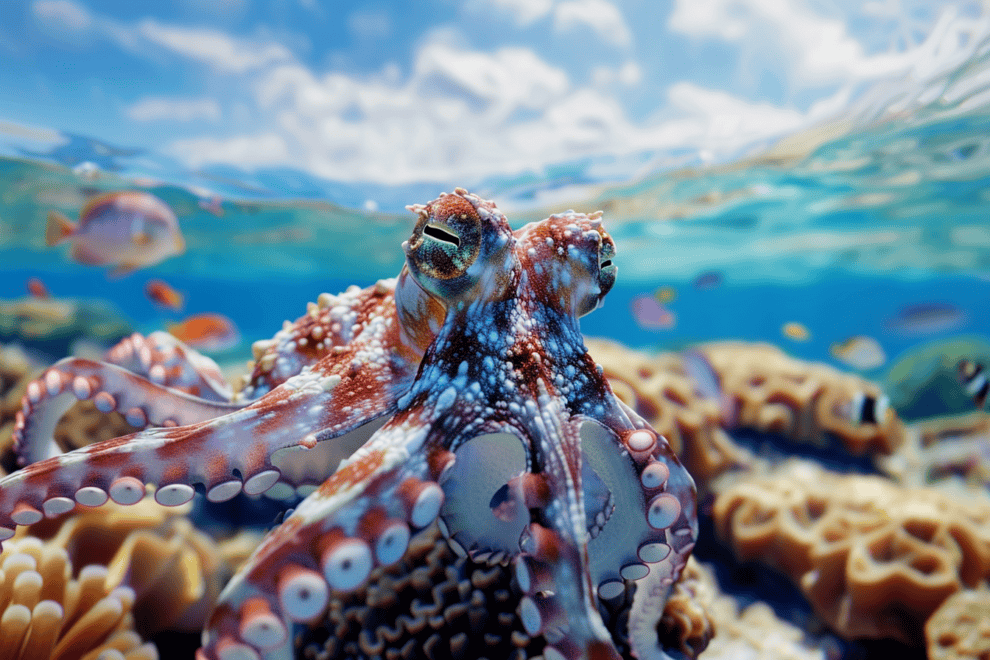The incredible mimic octopus is a true master of disguise found in the warm, shallow waters near Indonesia and the Great Barrier Reef.
This fascinating creature can transform its skin pigment and body shape to impersonate up to 15 different sea creatures. From venomous flatfish to dangerous sea snakes, its mimicry confuses predators and aids in survival.
These tropical habitats allow it to blend seamlessly with coral reefs and sandy bottoms while the octopus’s sophisticated camouflage techniques and intelligent behavior showcase its evolutionary prowess.
Where Does The Mimic Octopus Live?

The mimic octopus thrives in the warm, shallow waters near Indonesia and the Great Barrier Reef. This unique habitat allows it to blend seamlessly with coral reefs and sandy bottoms.
They have mastered the art of camouflage, using their surroundings to hide effectively and mimic other sea creatures. In these tropical waters, the mimic octopus can transform its appearance, easily adapting to various environments.
When you’re snorkeling or diving in these regions, you mightn’t even notice it as it expertly disguises itself as different sea animals, such as lionfish or flatfish. These camouflage techniques are essential for its survival, helping it avoid predators and catch prey.
The warm, shallow waters provide an ideal setting for the mimic octopus to showcase its incredible skills. By selecting such habitats, it guarantees it can use its adaptive abilities to their fullest potential.
Physical Characteristics

This remarkable cephalopod, naturally light beige, blends seamlessly with its surroundings in Indonesia and the Great Barrier Reef.
Using advanced camouflage techniques, it can transform its appearance to mimic up to 15 different sea creatures, including poisonous flatfish, deadly sea snakes, and lionfish.
When faced with threats, the mimic octopus employs its adaptive evolution to change color, shape, and movement instantly.
By doing so, it fools predators into believing it’s a more dangerous species. This intelligent behavior allows the octopus to confuse its enemies and escape before they’re any wiser.
Its ability to adapt its behavior to match the species it’s mimicking showcases its incredible survival strategy.
Over generations, the mimic octopus has perfected this mimicry trait, making it a master of disguise in the underwater world. The combination of its natural coloration, adaptive evolution, and sophisticated camouflage techniques cements its place as one of the ocean’s most fascinating and elusive creatures.
You can’t help but admire the ingenuity of the mimic octopus as it navigates the perilous waters of its habitat.
Mimicry Mechanisms

Harnessing its incredible mimicry mechanisms, the mimic octopus instantly transforms its appearance to confuse and evade predators.
This fascinating creature can change its color, shape, and movement to impersonate up to 15 different sea creatures. By mimicking poisonous flatfish, deadly sea snakes, and venomous lionfish, it uses evolutionary advantages to increase its chances of survival.
Behavioral adaptations play a vital role in its ability to deceive. When threatened, the mimic octopus doesn’t just look like another animal; it moves and behaves like one too.
This intelligent behavior allows it to adapt its actions to match the species it’s impersonating, enhancing mimicry effectiveness. It’s not simply a static disguise; it’s a dynamic act that changes based on the immediate threat.
This unique survival strategy has evolved to provide significant predation strategies. While its mimicry may not be flawless, it’s highly effective at giving the octopus enough time to escape.
The combination of visual deception and behavioral mimicry creates a formidable defense mechanism, showcasing nature’s ingenuity in self-preservation.
The mimic octopus’s ability to blend seamlessly into its environment illustrates how evolution can shape remarkably complex and effective survival tactics.
Mimic Octopus Predators and Prey

While the mimic octopus‘s mimicry mechanisms are impressive, its interactions with predators and prey highlight the true genius of its survival strategy.
The mimic octopus fools predators by impersonating more dangerous species like lionfish, sea snakes, and toxic flatfish. This incredible ability to shape-shift confuses predators, giving the octopus precious moments to escape and avoid being eaten.
The mimicry benefits are immense, as predators often mistake the octopus for its more threatening impersonations, allowing it to evade attacks and increase its chances of survival.
However, it’s not just about avoiding predators. The mimic octopus also uses its talents to confuse prey. By adopting various disguises, it can stealthily approach its prey, catching them off guard. This dual strategy of predator avoidance and prey confusion showcases its remarkable survival tactics.
Whether blending in with its surroundings or mimicking other sea creatures, the mimic octopus has evolved to outsmart both enemies and targets alike.
In the ever-dangerous underwater world, these survival tactics are crucial. The mimic octopus’s ability to seamlessly switch disguises ensures it remains elusive to predators while efficiently hunting its prey, underscoring its status as a master of disguise.
Conservation Status

Despite its remarkable abilities, the mimic octopus faces an uncertain future due to a lack of thorough research on its population and threats.
The species isn’t currently listed on the IUCN Red List, leaving its population trends largely unknown. This gap in knowledge makes it difficult to assess how many mimic octopuses are left in the wild or how their numbers are changing over time.
Conservation efforts are essential to protect this fascinating creature. These efforts primarily focus on safeguarding its habitat, which includes coral reefs and coastal areas. Pollution, overfishing, and habitat destruction pose significant threats to these environments. Climate change also looms as a potential risk, potentially altering the delicate balance of the octopus’s habitat and impacting its long-term survival.
To guarantee effective conservation strategies, more research and monitoring are imperative. Understanding the population size, distribution, and specific threats facing the mimic octopus can help create targeted protection measures.
Collaborative initiatives between researchers, conservation organizations, and local communities are crucial. By working together, we can preserve the mimic octopus and its unique adaptations, ensuring this master of disguise continues to thrive in its natural habitat.
Frequently Asked Questions
How Does the Mimic Octopus Communicate With Other Sea Creatures?
You’ll see the mimic octopus communicate with other sea creatures using behavioral signals and changing color patterns. It adapts these signals to mimic different species, conveying messages like danger, aggression, or attraction to navigate its environment.
What Are the Mating Rituals of the Mimic Octopus?
You’ll notice the mimic octopus engages in a courtship dance where the male cautiously approaches the female, gently stroking her arms. Mate selection follows, with the female either rejecting or accepting based on their interaction.
How Intelligent Is the Mimic Octopus Compared to Other Cephalopods?
You’d be impressed by the mimic octopus’s intelligence compared to other cephalopods. Its behavioral adaptations, like mimicking up to 15 species, showcase top-tier cephalopod intelligence, making it one of the smartest in its class.
Can the Mimic Octopus Be Kept in Home Aquariums?
You shouldn’t keep a mimic octopus in a home aquarium. Their tank requirements are complex and their feeding habits are specialized. They need ample hiding spots and varied diets, making them more challenging than typical marine pets.
What Is the Lifespan of the Mimic Octopus in the Wild?
The lifespan of a mimic octopus in the wild is around 1 to 2 years. You’ll find that their predator avoidance and camouflage techniques help them survive, reproduce multiple times, and secure their survival despite their short lifespan.









